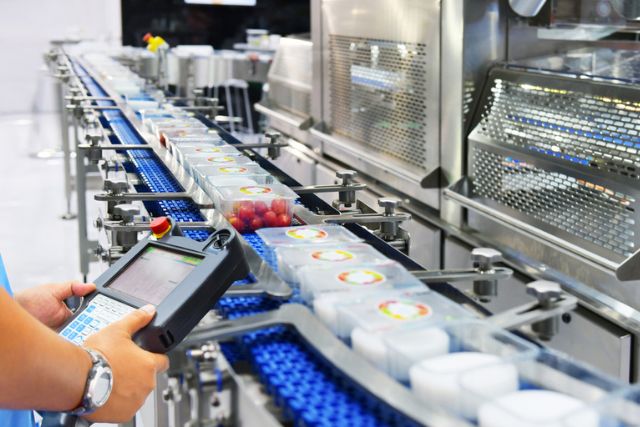
In recent months I’ve looked at how end-of-line robotics and operator efficiency training can each contribute to improving food factory practices and safety. Those subjects sit within the wider context of how automation and training increase food factory efficiency as a whole.
In this post, I wanted to delve a little deeper into how each aspect can result in significant improvements for food-based businesses.
How automation in the food industry is increasing productivity
It’s been reported that factory automation could improve efficiency by as much as 30%, yet only 31% of factory-based businesses have automated even a single part of their plants. That means there’s an enormous opportunity for businesses in every industry to increase efficiencies – including the food industry.
Examples of just how much automation can make food factories more efficient include:
Improving quality control
With so many workers, touchpoints and working processes, improving your quality control isn’t as easy as it sounds. Automation can help hugely in this area, reducing the potential for human error while simplifying some of the more intricate process flows. It’s one of the best ways to improve efficiency in your food factory.

Keeping workers safe
Factory line workers may fear automation as a threat to their job security, but in reality, automation actually helps them by taking some of the most repetitive tasks away, allowing them to do other more involved and interesting processes. In effect, automation actually helps workers to avoid the repetitive strain injuries that can come from lifting and placing items for hours on end, while also boosting efficiency of the factory line at the same time.
Increasing traceability
Traceability can be a significant challenge for food businesses. In fact, it’s one of the reasons I recently explored how 3D stereo microscopy might change food businesses in the near future.
In the here and now, however, automation is already making great strides to help food businesses in the battle against product recalls. With the right automation tools, food companies can locate where contaminated batches came from through the food chain, allowing them to isolate issues before they become a larger problem.
Enhancing output
As mentioned earlier, automation doesn’t just help workers avoid injury – it can also dramatically boost productivity across your factory. Automated technology doesn’t stop for food breaks or sleep, can gather data as it goes, and can report on faults as soon as they happen, freeing up the need for time-consuming regular manual checks. All of which shows in a big way how automation in the food industry is increasing efficiency – and, ultimately, profits.
Expanding flexibility and scalability
One of my big tips to boost efficiency in your food factory is that automation doesn’t just increase productivity – it also improves your factory’s agility when it comes to adding new product lines or growing your operation. If new processes are needed, automated factory technology means it’s a relatively simple case of installing the right hardware and programming it all as you need.
Reducing wastage
The amount of money food businesses lose on waste products is staggering. By reducing waste, automation tech can help those companies save thousands, hundreds of thousands, of pounds that can go back into new product development or enhancing food factory efficiencies further.
Training tips to boost efficiency in your food factory

Automation isn’t the only way food factories can increase efficiency. Indeed, research shows that factories with well-trained staff can also be up to 30% more productive.
Better still, the benefits from training food factory employees can include:
- Less expensive repairs from less user error
- Lower food waste from machines being set up incorrectly
- Decreased packaging spend from well-trained employees causing less accidental damage
Some helpful training tips to boost efficiency in your food factory include:
Be specific on the goals of training your team
At the outset of creating a training program you need to define the core knowledge your employees will need to do their jobs well, and the key performance indicators (KPIs) that you’ll measure to gauge the training’s effectiveness. Set these as SMART goals (making them Specific, Measurable, Achievable, Realistic and Time-based) to make sure you leave nothing to chance.
Gather operator feedback on what works and what doesn’t
Nobody knows your food factory line like the people working on it, so one of the best tips to boost efficiency in your food factory is to engage them early on with what needs to change and how training could help them make things better.
Give regular refreshers on both the why and the how
Giving employees training at the start of their employment might seem a no-brainer, but often food businesses can neglect to continue the up-skilling with refresher courses that both remind operators of the how (their best practices) and the why (serious safety and health issues they can avoid). These are especially helpful if you introduce new automation technology that fundamentally alters the way your staff interact with your factory line.
Take your training online
Manual training has a lot of pluses, including being able to show employees exactly how to use a piece of equipment en situ. However, it requires everyone to be in the same place at the same time, which can significantly affect productivity. Online training allows users to refresh their knowhow under their own steam, and is one of the best ways to keep everyone up to speed.
Need to improve the efficiency of your food business?
As I previously mentioned in my post on improving operator efficiency, the food production industry currently lacks a unified training standard. That’s why I’m currently working with some well-known food companies about to find solutions in both training and factory-line automation.
If you’re curious about how my contacts could help your food business increase its efficiencies, get in touch for a deeper dive.
Further Reading
- Improving Efficiencies in your Food Production Business
- Improving Operator Efficiency in Food Packing Halls
- The Importance of End of Line Automation in the Food Industry
- The Drive for Automation in Secondary Food Packaging Processes
- 3D Stereo Microscopy: How it Could Change Your Food Business Forever
- Current Trends Shaping the Food Industry
